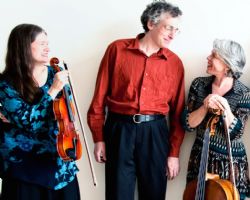|
Symphony
FROM THE NEW WORLD TO THE OLD WORLD
by Peter Lert
Saturday, June 14, 2025
Chamber
MC2 DUO RECITAL CLOSES 222'S SEASON
by Terry McNeill
Saturday, June 14, 2025
Choral and Vocal
CANTIAMO SONOMA'S LUSCIOUS A CAPELLA SINGING IN SEASON ENDING CONCERT
by Pamela Hicks Gailey
Sunday, June 8, 2025
Symphony
SRS SEASON ENDS WITH RESOUNDING TA-TA-TA-BANG
by Terry McNeill
Sunday, June 1, 2025
Symphony
YOUTHFUL VIRTUOSITY ON DISPLAY AT USO'S MAY CONCERTS
by Peter Lert
Saturday, May 17, 2025
Symphony
MYSTICAL PLANETS AND LIVELY GERSHWIN ORTIZ AT FINAL SRS CONCERT
by Peter Lert
Sunday, May 4, 2025
Symphony
VSO'S CONCERT MUSIC OF TIME, MUSIC OF PLACE
by Peter Lert
Sunday, April 27, 2025
VOCAL ELEGANCE AND FIRE AT THE 222'S RECITAL APRIL 26
by Pamela Hicks Gailey
Saturday, April 26, 2025
CANTIAMO SONOMA SINGS AN INSPIRED GOOD FRIDAY MOZART REQUIEM CONCERT
by Pamela Hicks Gailey
Friday, April 18, 2025
DRAMATIC SHOSTAKOVICH SYMPHONY CLOSES PHILHARMONIC'S 25TH SEASON
by Terry McNeill
Sunday, April 13, 2025
|
 |
 Left Coast Musicians A. Presler, E. Zivian and T. Tomkins |
KODALY DUO TRUMPS POPULAR MENDELSSOHN TRIO AT SLV CONCERT
by Terry McNeill
Wednesday, June 21, 2017
It’s not really a secret, but Sonoma County’s best chamber music series is one without much notoriety or publicity. The concerts at Santa Rosa’s Spring Lake Village programs are only for residents and a few invited guests. Impresario Robert Hayden years ago honed his producer skills as founder of the well-known Music at Oakmont Series, and now he often mounts two Spring Lake Village concerts a month in an intimate setting with excellent acoustics. No other North Coast music productions can equal his seminal accomplishment.
The June 21 concert featured Berkeley’s Left Coast Chamber Ensemble and drew 125 people to the Montgomery Center on a warm evening.
Eric Zivian, perhaps Northern California’s most active fortepiano artist, played the house’s conventional concert instrument and opened in two works, first one of Schumann’s Six Studies after Caprices of Paganini, and then Chopin’s F Minor Fantasy, Op. 49. Played from score, the Schumann was full of swirls of arpeggios and passed without much notice, and the famous Fantasy received a workmanlike interpretation that stressed speed in runs at the expense of tone color, inner voices and an assertive left hand line. The half-pedal runs contributed to sonic speed but not clarity and shape.
The concert closed with arguably the most popular piano trio ever written, Mendelssohn’s D Minor, and the performance should have the evening’s gem. Loaded with memorable tunes and richly hued contrasts, the reading by cellist Tanya Tomkins, violinist Anna Presler and Mr. Zivian we beset throughout by problems of balance. Mr. Zivian’s playing from the beginning sporadically overpowered his colleagues, and Ms. Presler lacked a strong thematic projection to blend with the piano part.
The Ensemble’s best playing came in the andante where the sonic mix was fluid, but even with the Mendelssohn’s glorious heart-on-sleeve themes there wasn’t enough tonal warmth and rhythmic subtlety to make the performance rise above the routine.
Tempos in the first three movements were convincing but in the concluding finale the tempo was pushed, generating occasional smudged notes. This music can take high speed but it needs clarity in articulation. This lack of ensemble continuity missed many small delights, including the delicious left-hand accents in the piano line that the composer surprisingly inserted, and a cohesive interplay of instrumental voices.
Kodaly’s Op. 7 Duo for Violin and Cello was far and away the concert’s highlight. Cellist Leighton Fong and Ms. Presler combined to give this rarely heard 24-minute work a scintillating performance that never felt extended or the lack of additional instruments. Composed in 1914, the three-movement Duo seems in a direct line to Janacek’s string quartets, especially the “Intimate Letters” Quartet written in 1928, and Kodaly’s own powerful Sonata for Solo Cello (Op. 8) that Alicia Weilerstein played here several years ago.
In the opening heroicallegro serioso the repeats had ample rubato and each had a different but subtle character. Beautiful playing was heard throughout, ending in a fast march and pensive chords before light filigree. The instruments were in perfect equality. Kodaly is a master of string pizzicato and positioning the violin constantly in the upper register, with many long-held notes on the E string. Ms. Presler played the demanding part with aplomb, sometimes leaning into a note and alternating a narrow and thick violin sound. Both Mr. Fong and Ms. Presler were able to clearly project the many turbulent passages, especially in the cello line.
The playing in the plaintive adagio was captivating, the themes exchanged often between cello and violin, and the acoustics of the hall favoring clear articulation. Often the instrumental voices were many octaves apart, but were always distinct, especially in the many descending three-note cello phrases. The playing underscored the music’s sadness, and in strange way its theatricality.
The improvisatory introduction to the last movement (maestoso e largamente) opened quietly and became dance like in the duo’s interpretation. Here Ms. Presler was particularly effective with accurate intonation and deft phrasing. Themes dramatically soared upward and then quietly subsided. Both players were carefully sensitive to the frequent contrasts in this rapidly evolving music, and their virtuosity was compelling and everywhere enjoyable. Mr. Fong’s cello had everywhere sonorous depth, ranging from a deep bass line up into the viola sphere.
Spring Lake Village concerts often spring musical surprises, so finding the sensational Kodaly performance displacing the ever-popular Mendelssohn Trio should not have been startling. That’s surely a reason to be a musical explorer.
|
